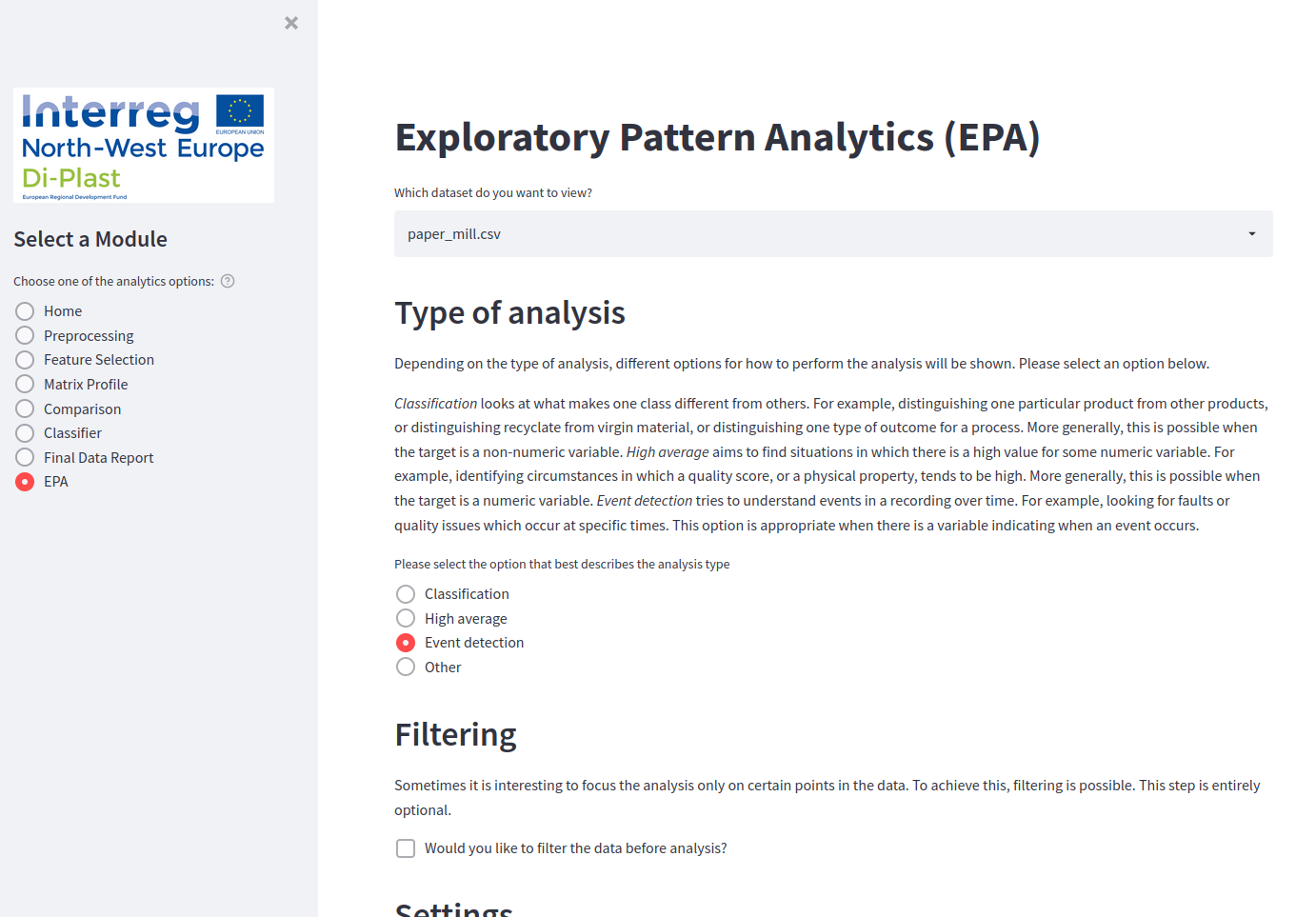 |
Exploratory Pattern Analytics:
An important step in data analysis is data exploration, to achieve a better understanding of the data. The Exploratory Pattern Analytics (EPA) tool works on prepared/preprocessed tabular data. It provides explanatory patterns, i.e., simple rules between some parameters (e.g., temperature, pressure) that are predictive for a certain target parameter (e.g., scrap rate). This provides important insights enhancing data understanding.For example, it could be used to better understand why certain known outliers occur in process data.
Type of tool: Local browser-based app
Short description of the tool:
An important step in data analysis is data exploration, to achieve a better understanding of the data. The Exploratory Pattern Analytics (EPA) tool works on prepared/preprocessed tabular data. It provides explanatory patterns, i.e., simple rules between some parameters (e.g., temperature, pressure) that are predictive for a certain target parameter (e.g., scrap rate). This provides important insights enhancing data understanding.
Required skills:
- Process/material knowledge: Knowledge of the data being analysed
- Digitalization knowledge: (Basic) knowledge of how to filter/preprocess data for analysis
Required programs (step-by-step guide and links provided in user guideline blow):
The EPA tool is integrated into the Data Analytics tool which requires the following programs:
- Python
- Java
- Anaconda
- Tool files from the GitHub (link below)
Disclaimer:
Disclaimer of Warranty
There is no warranty for the program, to the extent permitted by applicable law. Except when otherwise stated in writing the copyright holders and/or other parties provide the program “as is” without warranty of any kind, either expressed or implied, including, but not limited to, the implied warranties of merchantability and fitness for a particular purpose. The entire risk as to the quality and performance of the program is with you. should the program prove defective, you assume the cost of all necessary servicing, repair or correction.
Limitation of Liability
In no event unless required by applicable law or agreed to in writing will any copyright holder, or any other party who modifies and/or conveys the program as permitted above, be liable to you for damages, including any general, special, incidental or consequential damages arising out of the use or inability to use the program (including but not limited to loss of data or data being rendered inaccurate or losses sustained by you or third parties or a failure of the program to operate with any other programs), even if such holder or other party has been advised of the possibility of such damages.
This tool supports you to:
Explore your dataset, by finding interesting groups of data points within your data, which are described through simple patterns.
Example use case:
For example, the EPA tool could be used to better understand why certain known outliers occur in process data. The Exploratory Pattern Analytics tool makes it possible to find patterns that explain the data, in the form of rules that associate a certain combination of properties to a high probability of an outlier occurring. This can be an exploratory process, using input from business experts to refine the patterns. Ultimately, the rules found by the Exploratory Pattern Analytics tool make it possible to identify conditions under which an anomaly is more likely, making prediction easier and offering possible causal explanations – so that the anomalous behavior can be managed more effectively.
Tool guideline and access:
- ⚠️ We recommend to open and save the user guideline before proceeding. The guidline includes a detailed description of how to use the EPA tool with the example of a paper mill production process: guidelines
- The tool is available through the Data Analytics tool interface at: https://github.com/cslab-hub/DataAnalytics_Diplast . Installation instructions are included in the file named "Installation.docx". The python interface for programmers is available at: https://github.com/cslab-hub/sd4py
. Installation instructions are included in the file named "Installation.docx". The python interface for programmers is available at: https://github.com/cslab-hub/sd4py .
.
Contact person of the tool:
Dan Hudson mailto:daniel.dominic.hudson@uni-osnabrueck.de the University fo Osnabrück.
the University fo Osnabrück.
Related tools:
Before applying this tool:
We recommend also taking a look at the following Di-Plast tools below. They can help you to gather necessary information and data, help to better prepare your data and continue working with it afterwards:
--> Improve internal information and material flow -> VSM
--> Get guidance to set up a working data infrastructure -> Data Infrastructure Wiki
--> Find the right sensor to survey your process -> Sensor Tool
--> Validate your process data -> Data Validation
After applying this tool:
-->Analyse and Visualize your process data with data analytics -> Data Analytics
-->Match material requirements with material properties -> Matrix